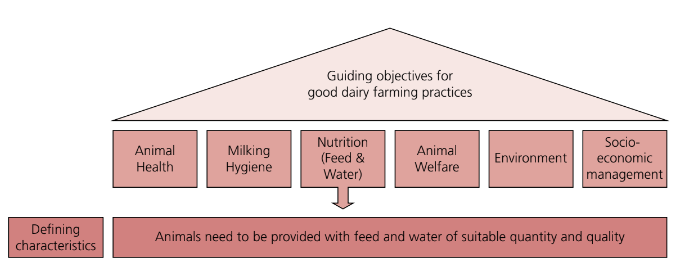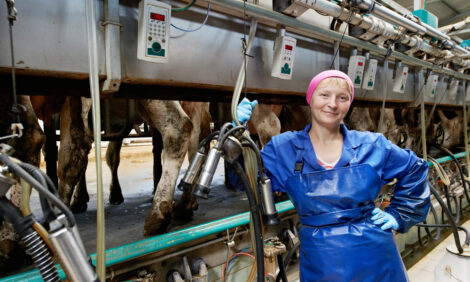



Guide to good dairy farming practice: Nutrition
Learn more about how feed, water and productivity are linkedPart of Series:
< Previous Article in Series Next Article in Series >
This article is from the Guide to Good Dairy Farming Practices, originally written and published by the Food and Agriculture Organization of the United Nations (FAO) and the International Dairy Federation. The Guide has been written in a practical format for dairy farmers engaged in the production of milk from any dairy species. When adopted, it will support the production and marketing of safe, quality-assured milk and dairy products. Additional sections of the Guide will be published as an article series.
The quantity and quality of the feed and water provided largely determines the dairy animal’s health and productivity, and the quality and safety of its milk. This Fact Sheet describes good dairy farming practice for managing animal nutrition, both feeding and watering. The suggested practices are set out under the following headings:
- Secure feed and water supplies from sustainable sources.
- Ensure animal feed and water are of suitable quantity and quality.
- Control storage conditions of feed.
- Ensure the traceability of feedstuffs brought on to the farm.

Secure feed and water supplies from sustainable sources
Plan ahead to ensure that the herd’s feed and water requirements are met
Budgeting the herd’s feed and water requirements in advance reduces risk and may help the dairy farmer identify less expensive sources of feed. Planning feed and water requirements ahead can enhance the sustainability of the farm enterprise. Utilise appropriate feeding and watering methods and infrastructure to ensure all live stock have adequate access.
Implement sustainable nutrient, irrigation and pest management practices when growing feed
Many farming systems rely on home grown feed for their livestock. Implementing good dairy farming practice includes managing the flow of nutrients on the farm, including the appropriate use of effluent and fertilisers for growing feed. Finite resources such as water for irrigation must also be managed sustainably. Implementing integrated pest management strategies can reduce chemical use.
Source farm inputs from suppliers implementing sustainable systems
Where possible, dairy farmers should consider sourcing farm inputs such as feed, water, fertiliser and energy from suppliers adopting sustainable practices, and so reduce the environmental impact of their own enterprise.
Ensure animal feed and water are of suitable quantity and quality
Ensure the nutritional needs of animals are met
Dairy animals should be provided with sufficient feed and water daily, according to their physiological needs. The quality and quantity of the feed, including appropriate fibre, should reflect the animal’s age, body weight, stage of lactation, production level, growth, pregnancy, activity and climate.
Sufficient space and time needs to be given for each animal to get access to feed and water. Good feeding management will reduce competitive pressure and diminish aggressive behaviours between individual animals.
Ensure the feed fed to dairy animals is fit for purpose and will not negatively impact the quality or safety of their milk or meat
Dairy farmers should ensure that the feed fed to dairy livestock does not contain chemical residues, toxins or other contaminants that pose a risk to animal health or the safety or quality of milk or meat derived from these animals. This can be achieved by carefully following the label directions of agricultural chemicals used on pastures and crops being grown for stock feed on the farm. Assurance about previous chemical treatments and the feed’s suitability as a stock feed should be sought from off-farm suppliers. Fence off or restrict access to areas where contaminated feed or toxic plants may be consumed by dairy animals. Inspect feed for signs of contamination or spoilage prior to feeding.
Ensure suitable quality water is provided and the supply is regularly checked and maintained
Fence stock water supplies to protect them from unintentional contamination. Water supplies should be of suitable quality and free of excrement. Many contaminants can enter water supplies and threaten the health or safety of people, livestock and the milking equipment rinsed with the contaminated water. The most common contaminants include pathogenic microorganisms and their toxins, as well as toxic chemicals such as pesticides, petroleum, solvents and nitrates. Contact the relevant authorities and have the water tested if there are any concerns about the suitability of the water for animals to drink.
Use different equipment for handling chemicals and feed stuffs
Never mix agricultural chemicals and/or veterinary chemicals in equipment or facilities used to handle feed or water for dairy livestock. Residues can remain on equipment or cross-contamination can occur via spills, air dispersal, back-siphoning effects etc.
Ensure chemicals are used appropriately on pastures and forage crops and observe withholding periods
Maintain stringent paddock records of all chemical applications to crops and pastures, and ensure grazing withholding periods are closely observed. Always follow the label for application rates and withholding times before allowing animals access to a treated field for grazing or forage harvesting. Always follow regulated processes for spray technologies.
check pasture for signs of pesticide drift. Look for signs of herbicide damage on forage plants. If signs are present, investigate further before allowing animals to graze. Be aware of the potential for spray drift when applying agricultural chemicals to pastures and crops. Take adequate precautions when allowing stock to drink the water after spray applications.
Find out about the past and present use of chemicals on your farm and neighbouring properties as spray drift may be a potential source of residues. When buying fodder or land, always obtain information on the paddock’s previous history of agricultural chemical use and/or conduct a soil or plant test if residues are suspected.
Only use approved chemicals for treatment of animal feeds or components of animal feeds and observe withholding periods
Only chemicals approved for use in dairy operations should be used. Chemicals should be managed in a manner that avoids their accidental introduction into the feed and water and, as a result, into milk. Use chemicals in accordance with manufacturers’ recommendations. Check labels of all chemicals that are to be used around, on or in feeds or pastures for compatibility with food-producing animals, withholding requirements for milk, and proper application rates and concentration of products. Withholding periods may also apply to pastures, forage crops and stored grains if they have been treated with an agricultural chemical. Different withholding periods may apply if the crop is also intended for human consumption.
Control storage conditions of feed
Separate feeds intended for different species
National regulations must be observed such that no prohibited animal material is included in dairy feed rations.
Ensure appropriate storage conditions to avoid feed spoilage or contamination
Ensure animals are not able to come into contact with contaminants in areas where these products are stored and mixed. These areas should be well ventilated as toxic fumes may be given off.
Ensure that feed is protected from contaminants. Store and handle pesticides, treated seeds, medicated feed and fertilizers properly. Store herbicides separately from other agricultural chemicals, fertilizers and seeds. Provide an appropriate vermin control programme for stored feed.
Hay and dry feeds should be protected from a moist environment. Silage and other fermented crops should be kept under sealed conditions.
Reject mouldy or sub-standard feed
Avoid feeding any mouldy feed to dairy animals. A wide range of feeds can contain poisonous fungal toxins that can be transferred to milk, particularly if they have not been stored correctly. Monitor feed for other gross contaminants such as plant or animal matter, metal, plastics, string and other undesirable items.
Ensure the traceability of feedstuffs brought on to the farm
Where possible, source animal feed from suppliers having an approved quality assurance programme in place
If you buy in feed, ensure the feed supplier has an assurance programme in place, can monitor appropriate residues and diseases and can trace the ingredients used back to their source. Ask for a relevant vendor declaration.
Keep records of all feed or feed ingredients received on the farm
Have an appropriate system in place to record and trace all feed or feed ingredients received onto the farm. Request a vendor declaration and/or a written consignment note with each feed delivery. Make sure you can identify and trace all treatments applied to feeds on-farm (including crop and grain treatments).
Reference: FAO and IDF. 2011. Guide to good dairy farming practice. Animal Production and Health Guidelines. No. 8. Rome.






